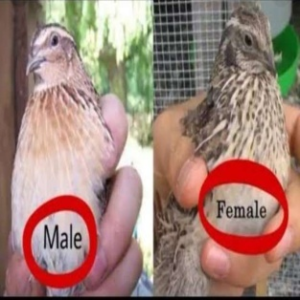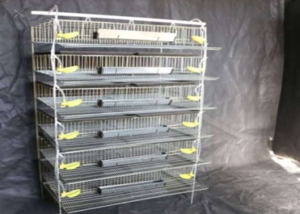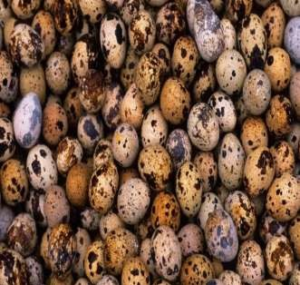QUAIL FARMING
Meenaxi1, Deepika Jamadar2
1Livestock Production and Management, Veterinary College, Bidar
2Assistant professor, Veterinary College, Bidar.
The term “Quail” refers to a collection of diminutive birds, known for their tendency to run rather than fly when confronted with danger, with the term itself connoting a state of trembling fear. The Japanese quail, also recognized as counter-mix quail, pharaoh’s quail, eastern quail, bater (Hindi), and battai in Nepali, is part of this group. Quails are extensively distributed across Europe, Africa, and Asia, often considered migratory creatures. Initially kept as pets, quails are now predominantly utilized for both meat and egg production. Quail eggs typically weigh between 7 to 15 grams, while adult quails weigh between 150 to 200 grams. These eggs are aesthetically pleasing, displaying a variety of colors. In their first year of life, quails can lay approximately 300 eggs, with production gradually declining to 150-175 eggs in the second year and subsequent years.
Keywords: Breeds, housing system, Brooding management, reproduction
Quail Breeds:
- Japanese quail (Coturnix Japonica): commonly known as Bater.Utilizedfordevelopingspecializedeggandmeat linesofquail.
- Bob white quail (Colinus virginianus): Birds are without tail,heavy and have white colored plumage as dominant character
| CARIbrown | CARI
pearl |
CARI
sunheri |
CARI
sweta |
CARI
uttam |
CARI
ujjwal |
|
| Plumagecolor | Completelybrown | Whitebreastedbrown | Whitebreastedbrown | White | Pharaoh | Whitebreastedquail |
| BWT(5wk) | 218 | 140 | 182 | 155-165 | 220 | 200 |
| FE (5thweek) | 2.70 | 2.50 | 2.80 | 2.70 | 2.60 | 2.80 |
| Daily feedintake(g) | 9 | 20.25 | 10 | 25 | 25-28 | 25-28 |
| Ageatsexualmaturity(d) | 38-41 | 44 | 43 | 42 | 42-46 | 40-43 |
| Annualeggproduction | 210 | 285-295 | 200 | 215 | 260 | 240 |
| Ageatpeakproduction | 10 | 10 | 12-13 | 11 | 10 | 10-11 |
| Hatchability(%) | 60-65 | 70-80 | 68 | 50-60 | 70-75 | 65-70 |
| Livability (%) | 90 | 95 | 95 | 80 | 96 | 97 |
| DP(%) | 74 | 72 | 72 | 73 | 74 | |
| Egg | Tinted | white | Tinted | Tinted | Tinted | tinted |
DIFFERENCEBETWEEN MALE ANDFEMALE
- Physical Appearance:
| Characters | Male | females |
| Size | slightly larger | Smaller than male ( difference may not be very noticeable) |
| Plumage | more colorful and striking plumage | Less compared to females |
| Comb | larger combs | Smaller |
| Wattle | larger | Smaller |
- Voice and Behavior:
- Call: Male quails are known for their distinctive calls, which they use to establish territory and attract mates during the breeding season. Female quails may also vocalize but usually have quieter calls.
- Aggression: During the breeding season, male quails can become more aggressive, particularly towards other males competing for mates. This aggression may manifest in behaviors such as chasing, pecking, or vocal displays.
- Nesting Behavior: Female quails are responsible for incubating eggs and caring for chicks. They exhibit nesting behaviors such as scratching at the ground to create a nest, laying eggs, and incubating them until hatching. Males may assist in guarding the nest but typically do not participate in incubation.
- Reproductive Anatomy:
- Male quails have reproductive organs such as testes and a phallus, which are involved in sperm production and mating. Rustybrownthroatand breastfeathers,cloacalgland.
- Female quails have reproductive organs such as ovaries and oviducts, which produce and release eggs. They also have a cloaca, a common opening for excretion and reproduction, where eggs are laid. long and pointedfeathers with black speckles onthroatandupperbreast. Chest is broad and Femalesareheavier (200-250g) then male-(180-200g).
- Understanding these differences between male and female quails is important for various aspects of quail farming, including breeding management, flock health, and behavior observation. Proper identification and management of male and female quails can help maximize breeding success and overall productivity in quail farming operations.
FEEDING OF QUAIL
- Brooder feedup to3 week: high protein diet-27.5% high energy diet-2850kcal/kg
- Grower feed 4th weekon wards:24% protein 2750-2800kcal/kgenergy
· layer feed content:22.5%protein 2700kcal/kgenergy
- Quails start laying by:6–7-week age
- They reach peak production of laying:13-14 week,
- Gradually decline egglaying from25th week
- Hen housed egg production ranges-260-275eggs
HOUSING SYSTEM OF QUAILS
Quail can be raisedin bothlitter and cagesystems.
- DEEPLITTERSYSTEM
6 quails canbe reared ina sq.ftof floor space. Litter materials-paddy husk, ground nuthull,saw dust. Depth oflitter -2.5cm during brooding then 5cm. After2 week quail can be reared in cages.
- CAGE SYSTEM
Quail farming in cage system is more suitable than raising them in deep
litter system managementisveryeasy anddiseasesandother problemsareless usewirenetformakingtheircages. Commercialegg layerisusuallyhousedincoloniesof10-12birdspercage.Each unit is about 6 feet in lengthand1footinwidth andsubdividedinto 6 subunits.Thecagescanbe arrangedupto6tiershigh. Bottomofcageisfixedwithremovablewoodenplates. Long narrow feedtroughsareplaced in frontof thecages. Water troughs are placed at the backof thecages.
Reproduction and Breeding
In quail farming, reproduction and breeding play a crucial role in ensuring a consistent supply of eggs for consumption or for hatching chicks for meat production or replenishing the flock. Here are some scientific insights into quail reproduction and breeding:
- Sexual Maturity:Quails reach sexual maturity relatively early compared to other poultry species. Japanese quails, for example, typically reach sexual maturity at around 6 to 8 weeks of age.
- Natural Mating:Quails are capable of natural mating, where males court females by performing a mating dance, including vocalizations and physical displays. Once a pair forms, mating occurs quickly and can be frequent, especially during the breeding season.
- Artificial Insemination: This technique allows for controlled breeding and enables the use of selected males with desirable genetic traits to fertilize a larger number of eggs.
- Breeding Ratio:The ideal male-to-female ratio in a breeding flock depends on several factors, including the breed, housing conditions, and management practices. Generally, a ratio of 1 male to 4 to 6 females is recommended to ensure efficient fertilization without causing excessive stress or aggression among the birds.
- Nesting and Egg Laying:Quails prefer to lay their eggs in secluded areas or nest boxes within their enclosure. Providing suitable nesting sites encourages natural egg-laying behavior and helps prevent egg damage or cannibalism. Japanese quails typically lay small, speckled eggs, with each female capable of producing several eggs per week under optimal conditions.
- Incubation:Quail eggs require specific conditions for successful incubation. The optimal temperature for incubating quail eggs is around 37.5 to 38 degrees Celsius (99.5 to 100.4 degrees Fahrenheit), with a relative humidity of approximately 60% to 70%. The incubation period for quail eggs is relatively short, typically lasting around 17 to 18 days.
- Hatchery Management:Proper hatchery management practices are essential for maximizing hatchability and chick health. This includes regular egg collection, careful handling and storage of eggs before incubation, maintaining appropriate temperature and humidity levels during incubation, and providing adequate nutrition and care for newly hatched chicks.
- Genetic Selection:Selective breeding programs can be employed to improve desirable traits in quail populations, such as egg production, meat quality, disease resistance, and growth rate. By selectively breeding individuals with the best genetic characteristics, farmers can gradually improve the overall performance and profitability of their quail flocks over successive generations.
BROODING ARRANGEMENTS
- The brooder house should be thoroughly cleaned and disinfected at least a dayinadvanceto receivethe chicks.
- Littermaterialslikepaddyhuskor groundnuthullsisspreadtoabout2.5cmdepth andnewspaperisspreadoverit.
- Abrooderguardintheformof acardboardsheetor metallicsheetabout30-45cmin heightisarrangedina circle overthenewspaperonthelittermaterial.
- Japanese quail chicks are very tiny and cannot adjust themselves to a chill environment.Hence, adequate warmth must be ensured by providing infrared bulbs and a gasbrooderat thecenterofthe brooder.
- Artificialheat and tempmanagementsystemfor14to 21daysfrombirth.1stweekrequiredtemp35ºCthengraduallyreduced to3.5°Cperweekuntilthechickswere fullyfeatheredat about4 weeks.
JAPANESE QUAIL EGG
- Quaileggsaretasty;theycontainmoreyolkthan chickeneggs.
- Smalleregg thanchicken
- Quail eggs contain higher proportions of high-quality protein and Less fat and cholesterol
- Eggslaidbetween3to5pm, weight is around 10-12g, 7to8%of
hensbodyweight.The averageageat1steggproductionisabout
JAPANESE QUAIL MEAT
- Japanesequailcan besold tothemarket at 5weeksofageas live birds.Dressingpercent- is 70-75%
- Cleanedmeatwillbe70-74percent ofthelivebody weight,quails carrymoremeatinthe breastregion(41percent)andalso contain ahighamountof calcium.
- Quailmeatcontainsmoreprotein(22-24percent)and lessfat (about2percent)thanmostotherkindsofmeat,likemutton,chicken,etc.
ADVANTAGES AND DISADVANTAGES OF QUAIL FARMING
The advantages are as follows:
- Quail is known for its fast growth and veryshort generationinterval. (3to4generationsinyear)
- Quail farming needslowinvestment and they are very resistanttodiseases.
- Easytohandle and Novaccinationis required
- Earlymaturitymarketingagewithin4thweek-5weeks.
- Veryhighegg-layingintensity:The femalestartslayingattheageof42daysand reachestopeakproductionby 10-12weeksofage. They requireminimumfloorspace
- Quailmeatistestierthanchickenhaslessfatcontentanditpromotesbodyandbraindevelopmentin children.
- Known for its rate of egg laying -280eggs/yrand eggscontainlesscholesterol.
Disadvantages:
- Quailhasaparticularlyhighamountofammonia contentindroppingand odor may be objectionable.
Arapiddeclineinreproductiveefficiency, after8monthsofage.
- Shelldamageoccursfrequentlyin quaileggs and candling is difficult due to colored egg shell
- Newly hatchedchicksaresensitiveto draftsandmustbe givenspecialcareduring1stweek or2 weeksof age
- Fertilityandhatchabilitypercentagesaregenerallylowerthan theturkeyand chickens.
Diseases of Quail
- More resistant to common poultry diseases (Naveeen and Arun 1992)
- Maximum mortality is during the brooding period.
Ulcerative Enteritis
- Causative agent: Corynebacterium perdicum, Clostridium perfringes
- 100% mortality in young quails
- Typical signs: birds die with feed in crop.
Important symptoms:
- Watery droppings with urates
- Birds became dull, humped up, ruffled feather and partially opened eyes.
- Ulceration in intestine and caeca.
- Liver – lesions are yellow spots with yellowish area of necrosis with edge of liver.
- Spleen – Enlarged and hemorrhagic
- Upper part of intestine hemorrhagic lesions.
Aspergillosis
- Causative agent: Aspergillus fumigatus
Bronchitis
- 80% mortality in young birds
- Caused by filterable virus serologically distinct from infectious bronchitis
- Disease characterized by-
- Sneezing
- Coughing
- Tracheal rales
- No nasal discharge
Ranikhet disease
- Sprodic cases
- Lasota vaccine
Coccidiosis
- Only seen sporadic cases
Reference
- http://agritech.tnau.in /farmenterprises/Farm
- http://cpdobbser.in/cpdobbser/pdf/Quail management guide.pdf
- K. A and C. S Arun, 1992.Diseases of quails. Poult. Adav 25: 43-48







